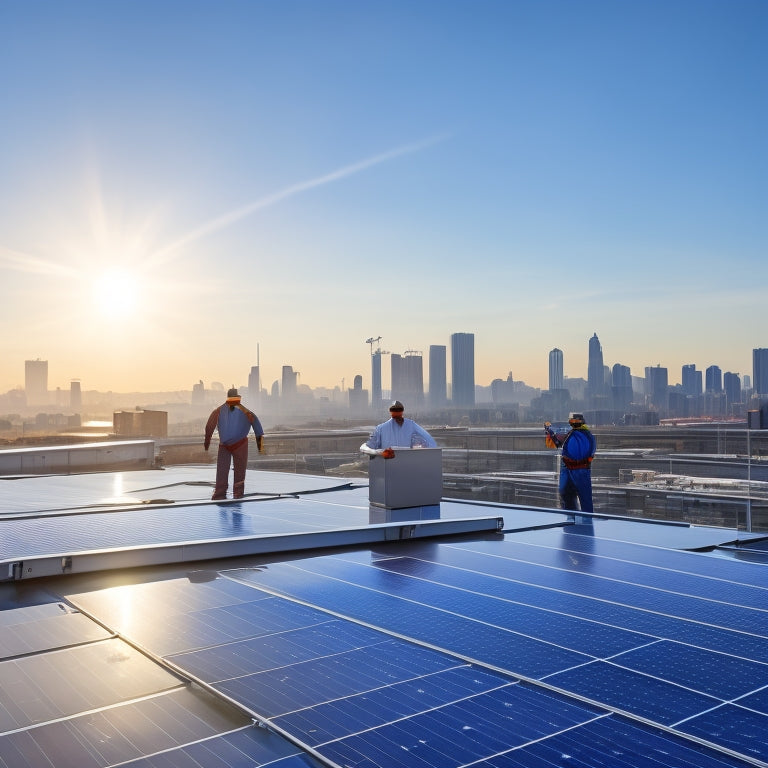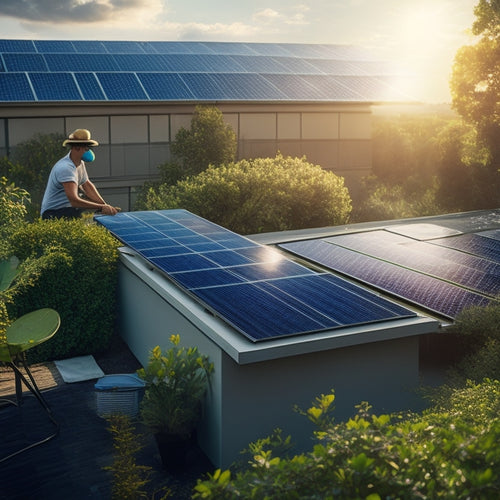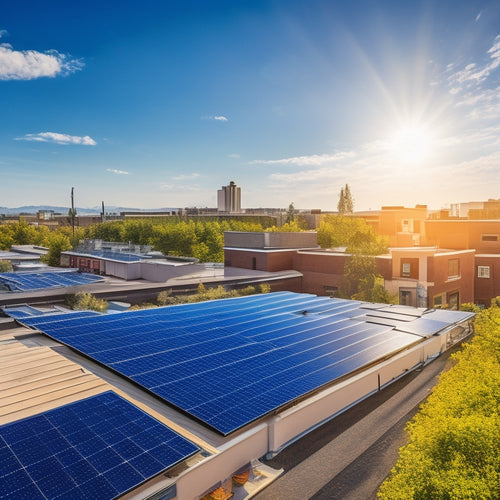
Average Costs of Commercial Solar Panel Maintenance
Share
On average, you should budget $15 to $25 per panel annually for commercial solar panel maintenance. Key factors influencing this include labor for skilled technicians, regular inspections, cleaning expenses, and potential repair or replacement of components like inverters and wiring. Additional costs come from monitoring systems and the necessity for software updates. Insurance policies and proactive maintenance can minimize long-term expenses. Panel size, age, and location also affect overall costs. Proper maintenance guarantees peak energy production, extending system lifespan and cutting operational costs. To optimize your investment, explore further on how each aspect can impact your budget.
Key Takeaways
- Skilled technicians typically charge $100 to $150 per hour for maintenance services.
- Regular inspections, recommended biannually, can cost between $200 and $400 each.
- Cleaning costs vary, with manual cleaning around $3 to $10 per panel and automated cleaning systems costing more.
- Repairing inverters or replacing panels can range from $500 to $3,000, often covered under warranties.
- Monitoring systems with real-time data and updates can cost between $200 and $800 annually.
Overview of Maintenance Costs
Understanding the various components that contribute to the overall maintenance costs of commercial solar panels is essential for accurately budgeting and ensuring long-term system efficiency. One significant aspect to take into account is the warranty terms provided by the manufacturer. Typically, these warranties cover specific defects and performance guarantees for a set period, often 10 to 25 years. However, warranties don't always include routine maintenance or incidental damages, which can lead to additional out-of-pocket expenses.
Insurance coverage is another critical factor affecting maintenance costs. Thorough insurance policies can protect against events such as natural disasters, theft, or vandalism, which might otherwise result in significant repair or replacement costs. It's important to review your insurance policy in detail to understand what's covered and any potential exclusions that could result in unexpected expenses.
Regular maintenance requirements, such as cleaning and minor repairs, often fall outside of warranty and insurance coverage. These ongoing costs are necessary to ensure the system operates at peak efficiency and should be factored into your overall budget.
Labor and Inspection Fees
Labor and inspection fees form a substantial portion of the maintenance budget, as these costs encompass routine system checks, troubleshooting, and professional services necessary to sustain peak performance. You'll need to account for both the labor costs associated with hiring trained technicians and the frequency of inspections to guarantee the best system functionality.
Technician training is critical, as skilled personnel are more efficient at identifying and rectifying potential issues, thereby minimizing downtime and enhancing system longevity. Trained technicians command a higher hourly rate, typically ranging between $50 to $100 per hour, depending on their experience and the complexity of the system. However, this investment is justified by the precision and efficiency they bring to the maintenance process.
Inspection frequency is another key factor influencing costs. Regular inspections, often recommended quarterly, help in early detection of issues, reducing the likelihood of costly repairs down the line. Each inspection can cost between $200 and $500, depending on the system's size and location.
Cleaning and Washing Expenses
Cleaning and washing expenses are essential components of your maintenance budget, as accumulated dirt and debris can greatly reduce the efficiency and energy output of commercial solar panels. The cleaning frequency is a critical factor to take into account, typically varying from once every six months to quarterly, depending on environmental conditions such as pollution levels, bird activity, and local weather patterns.
When determining costs, you'll need to evaluate the washing methods employed. Common techniques include manual cleaning with water and biodegradable detergents, which may range from $150 to $400 per cleaning session for an average commercial installation. Automated cleaning systems, although having higher initial setup costs, offer long-term savings by reducing labor expenses and ensuring consistent cleaning frequency. These systems can cost between $0.02 and $0.05 per watt annually.
It's important to weigh these costs against potential energy losses due to dirty panels. Studies indicate that unclean panels can suffer efficiency drops of up to 20%, significantly impacting your return on investment.
Repair and Replacement Charges
When considering repair and replacement charges, you should assess common repair costs like inverter failures, wiring issues, and panel damage. These costs can range from $100 to $3,000 depending on the severity.
Panel replacement rates vary widely, typically costing between $200 to $1,000 per panel, including labor.
Analyzing these expenses is essential to accurately project long-term maintenance budgets.
Common Repair Costs
Repair and replacement charges for commercial solar panels can vary greatly, often depending on the specific component and the extent of the damage. For example, if you face inverter issues, costs can range from $1,000 to $3,000, depending on whether a simple repair or a complete replacement is necessary. Inverters are essential for converting DC electricity to AC, so any malfunction can greatly impact your system's performance.
Your warranty coverage plays a pivotal role in managing these expenses. Manufacturers typically offer warranties that cover specific components, often for 5 to 10 years. Reviewing your warranty coverage can help you understand what's included and potentially save thousands on repair costs.
Other common repairs include fixing or replacing wiring, which can cost between $500 and $2,000. Damaged wiring can lead to substantial efficiency losses and even safety hazards.
Monitoring systems also occasionally need attention; repairing these can cost from $300 to $1,000, depending on the complexity of the issue.
Panel Replacement Rates
Panel replacement rates for commercial solar systems can have a substantial impact on your overall maintenance budget, with costs ranging from $200 to $500 per panel depending on factors such as panel type, labor charges, and the extent of the damage. Understanding these costs is vital for managing long-term operational expenses effectively.
Several critical factors influence replacement rates:
-
Installation Quality: Poor installation practices can lead to frequent panel replacements. Ensuring high installation standards can greatly reduce long-term maintenance costs.
-
Warranty Coverage: Examine your warranty terms. Some warranties cover panel replacements under specific conditions, which can help mitigate out-of-pocket expenses.
-
Type of Panel: Different types of panels (monocrystalline, polycrystalline, thin-film) have varying replacement costs. High-efficiency panels often come with steeper replacement fees.
- Labor Charges: Labor costs fluctuate based on location and complexity of the replacement. Urban areas typically incur higher labor expenses than rural settings.
Evaluating these factors allows you to anticipate and budget for potential replacement costs accurately. By investing in high-quality installation and understanding your warranty coverage, you can alleviate some of the financial burdens associated with panel replacements. This proactive approach ensures your commercial solar system remains efficient and cost-effective in the long run.
Monitoring System Costs
Investing in a robust monitoring system is essential for optimizing the performance and longevity of commercial solar panels. These systems provide real-time data on energy production, system efficiency, and potential issues, enabling timely interventions and minimizing downtime.
Though it does introduce additional costs, when considering monitoring system costs, you'll need to account for both initial setup and ongoing expenses. Initial costs typically include hardware installation and software licensing fees. Many advanced systems also require periodic software updates to guarantee peak performance, which can incur additional charges. These updates are vital for maintaining compatibility with evolving technologies and enhancing system capabilities.
Data storage is another critical component. Monitoring systems generate substantial amounts of data that need to be stored securely. Costs for data storage can vary based on the volume of data and the duration of storage. Cloud-based solutions often offer scalable storage options but can introduce recurring fees.
Long-Term Maintenance Savings
Realizing long-term maintenance savings hinges on implementing proactive maintenance strategies that mitigate costly repairs and extend the lifespan of your commercial solar panels. These strategies not only optimize system performance but also guarantee you capitalize on warranty benefits and reduce unexpected expenses.
To achieve significant cost savings, consider the following:
-
Regular Performance Monitoring: Continuous monitoring allows you to detect inefficiencies early. By using advanced monitoring tools, you can pinpoint underperforming panels and address issues promptly, minimizing energy loss and repair costs.
-
Scheduled Preventative Maintenance: Routine inspections and cleanings help maintain peak performance. This proactive approach prevents minor issues from escalating into major, costly repairs, ensuring your system runs smoothly year-round.
-
Warranty Benefits Utilization: Take full advantage of manufacturer warranties. Familiarize yourself with the terms, and promptly report any covered issues to avoid out-of-pocket expenses. Proper documentation and adherence to guidelines can maximize these benefits.
- Component Upgrades: Periodically upgrading system components can enhance efficiency and longevity. Investing in high-quality inverters and other parts can reduce the frequency of maintenance and extend the overall system lifespan.
Frequently Asked Questions
How Often Should Commercial Solar Panels Be Inspected?
You should inspect commercial solar panels at least twice a year. Regular inspection frequency guarantees peak performance monitoring, identifying issues early, and maintaining efficiency, ultimately leading to cost-effective long-term operation and energy savings.
What Factors Influence the Lifespan of Commercial Solar Panels?
Imagine your solar panels are like fine wine; they age, but not always gracefully. Factors like panel degradation and installation quality play key roles in their lifespan. Proper installation and quality materials can greatly slow down degradation.
Are There Any Government Incentives for Maintaining Solar Panels?
Yes, you can benefit from government subsidies and tax rebates for maintaining solar panels. These incentives reduce your overall costs by offsetting maintenance expenses, ensuring your investment remains profitable and your panels operate efficiently.
Can Adverse Weather Conditions Affect Maintenance Costs?
Picture a ship traversing stormy seas—adverse weather conditions can similarly impact your solar panels, resulting in maintenance fluctuations. Weather impact often drives costs higher due to increased wear and tear, requiring more frequent servicing.
What Are the Common Signs That a Solar Panel Needs Maintenance?
You should look for performance degradation and conduct a visual inspection to spot common signs of solar panel maintenance needs. Performance drops, discoloration, and physical damage are key indicators that maintenance is required.
Conclusion
To conclude, maintaining commercial solar panels involves several key expenses: labor and inspection fees, cleaning costs, repair and replacement charges, and monitoring system costs.
While these outlays can seem significant, it's important to remember that regular upkeep prevents costly breakdowns and maximizes efficiency.
Think of it as 'penny-wise, pound-foolish'—skimping on maintenance now will cost you more in the long run.
By investing in consistent care, you'll guarantee long-term savings and sustained energy production.
Related Posts
-
Trends in Renewable Energy Storage Technologies
You're witnessing rapid advancements in renewable energy storage technologies aimed at improving efficiency and scala...
-

Green Ways to Maintain Solar Panels
To maintain your solar panels sustainably, start with regular inspections to catch potential issues early, enhancing ...
-

Solar Energy Solutions for Small Businesses
Switching to solar energy can be a game changer for your small business. You'll enjoy significant cost savings on mon...

